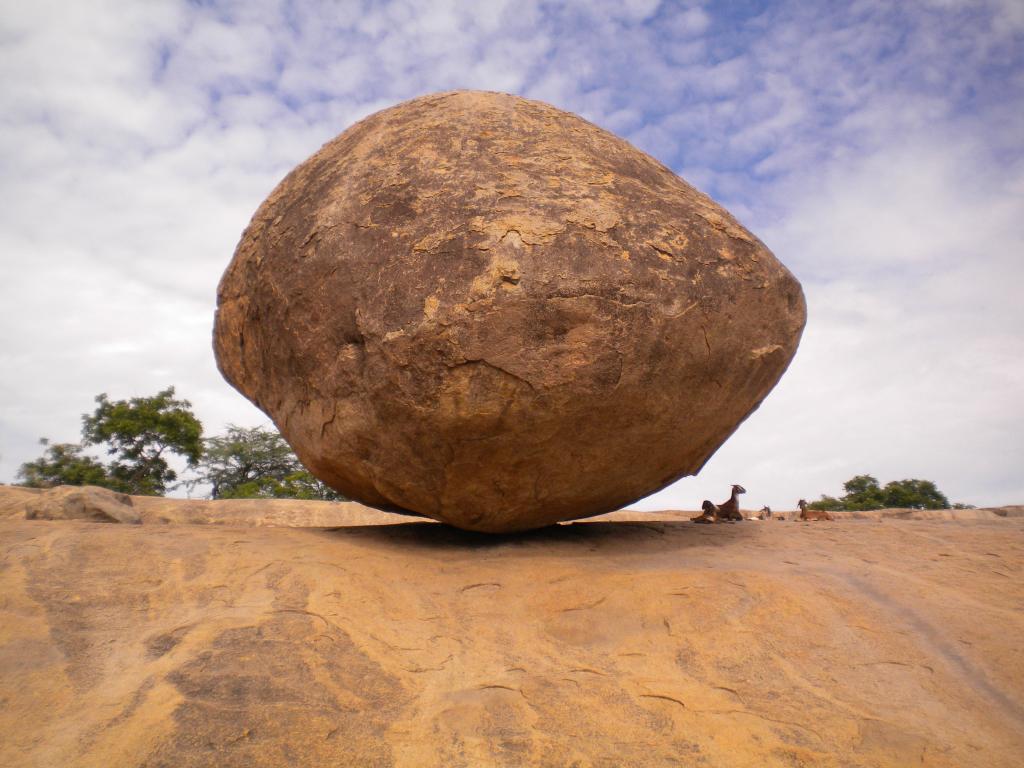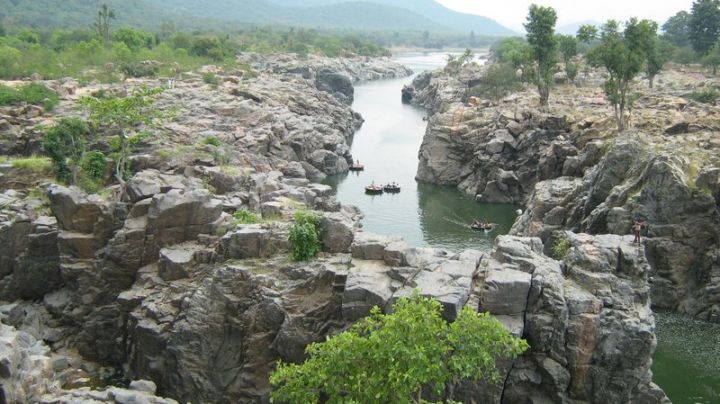Archean Formations
Sathyamangalam GroupThe major rock types are Fuchsite Quartzite, Garnetiferous Quartzite, Magnetiferous Quartzite and Kyanite Quartzite are commonly known as Bhavani Layered Complex. This Group is found in the districts of Erode, Namakkal, Karur and parts of Salem. It contains Platinoid group of elements and are under exploration by agencies.
Bhavani Gneissic ComplexThe major rock types are Gneisses, metamorphosed rocks mainly found in the areas of Gobichettipalayam and Bhavani Sagar. These Gneisses are worked for production of ornamental and dimension stones.
Khondalite GroupThe rock types are Garnet Sillimanite Gneiss, Quartzite, Calc-Granulite, Crystalline Limestones. This Group is distributed in the Western Ghats of Southern Granulite Terrain. The chief occurrence of minerals are Graphite in Sivaganga and Madurai, Limestone in Tirunelveli, Thoothukudi, Virudhunagar and Dindigul, Granite in Madurai, Pudukkottai, Tirunelveli, Thoothukudi, Virudhunagar and Dindigul and Beach Sand deposits in the districts of Tirunelveli, Thoothukudi and Kanniyakumari.
Kolar GroupThis Group consist of Schist, a type of metamorphosed rock. This rock contain auriferous mineral and the commercial value is under examination. This rock is found in Bargur, Maharajakadai and Vepannapalli in Krishnagiri district and Devala in the Nilgiris district.
Anorthosite ComplexThe rock types in Anorthosite Complex are Dunite, Garnetiferous Granulite, Gabbro and Chromite. The Sittampundi Anorthosite Complex and Oddanchatram Anorthosite Complex, Mamandur Anorthosite Complex cover the districts of Salem, Namakkal, Karur, Dindigul and Villupuram.
Archean to Proterozoic
Charnockite GroupThe name Charnockite was given to the rock in Honour of Job Charnock, the founder of Calcutta, whose tombstone was built by this rock. This rock was discovered by Sir Thomas Holland in 1900 in St. Thomas Mount, Pallavaram, Chennai. It consists of Hypersthene bearing minerals and blue Quartz imparts the blue colour to the rock and hence called Blue Metal. This type of rocks occur in Gneissic terrain in most parts of Tamil Nadu predominantly in the Nilgiris and Palani Hills.
GranitesThese rocks derived either from igneous or sedimentary rocks altered by metamorphism due to extreme heat and pressure. The Granites occurs in two different types namely Black and Coloured Granite. Black Granites geologically known as Dolerite predominantly occurs as dyke in the districts of Kanchipuram, Vellore, Tiruvannamalai, Villupuram, Dharmapuri, Krishnagiri, Salem and Erode. Coloured Granites occur in Madurai, Dharmapuri, Krishnagiri, Virudhunagar, Pudukkottai, Salem, Karur and Namakkal. The Granites are mainly used for the ornamental decorative purpose.
Migmatitic ComplexMigmatites are the rocks formed by multiple deformation due to repeated metamorphism. The Migmatites are formed as dykes, sills, ultramafic bodies and in Carbonatite Complex. The dykes and sills of Migmatites occur widespread in Gingee called Gingee Migmatites, Anaimalai hill ranges of the Western Ghats, Tirunelveli, Krishnagiri, Dharmapuri. Ultramafic bodies of Migmatite Complex is rich in Dunite, Peridotite and Pyroxenite in places traversed by Magnesite veins occurs widespread in Chalk Hills of Salem and Namakkal districts.
Proterozoic
UltramaficUltramafic formation is formed due to high pressure metamorphism trending Moyar-Bhavani- Attur (MBA) and Palaghat- Cauvery (PC) associated with Gabbro-Anorthosite Complex. Ultramafic bodies are mostly made with Dunite, Peridotite and Pyroxenite.
The largest ultramafic body in the State is named as “Chalk Hills” consisting veins of white Magnesite spread over an area of 17 sq.km near Salem town. Kanjanur ultramafic Complex near Samalpatti in Dharmapuri district spread over an area of 30 sq.km forming a crescent shaped unit in which Peridotite, different types of Pyroxenites, Serpentinites are traced in the Complex. Sirapalli ultramafic Complex consist of serpentinized Dunite traversed by Magnesite veins.
Alkaline rocks and CarbonatitesMost alkaline – Carbonatites Complex are traced in the western part of Tamil Nadu. The seven Carbonatitie occurrences in Tamil Nadu include Sevathur, Samalpatti, Jogipatti, Karapattu, Hogenakkal, Pakkanadu and Cumbum. In general, the alkaline Carbonatite bodies have an arcuate disposition and marked by ultramafic rocks in the core and Syenite in the periphery. Sivanmalai Syenite Complex in Coimbatore district consist of Granite Gneisses, Amphibolites and Granulites with prominent rock type being Nepheline Syenite.
In the Granulitic terrain of South India, diverse lithologies including Granite, Syenite, Nepheline Syenite, Carbonatite, Anorthosite, Pyroxenite and Gabbro are known. Some of the rock types available in the State are located as follows:
- Yelagiri - Pyroxenite, Syenite
- Sevathur, Koratti and Hogenakkal – Pyroxenite, Syenite, Carbonatite
- Samalpatti and Pakkanadu – Dunite, Pyroxenite, Syenite, Carbonatite
- Kambamettu – Carbonatite
- Putteti - Syenite
Based on the distribution of the granite bodies, they may be grouped as
- North of the Moyar-Bhavani tectonic zone (Granite formation in Gingee, Sholingar and Thirukovilur granites of Villupuram and Vellore districts)
- Central part between the Moyar-Bhavani tectonic zone and the Palaghat-Cauvery zone (Granite formation in Maruthamalai, Karamadai, Sirumugai and Thiruchengodu of Coimbatore and Namakkal districts)
- South of the Palaghat – Cauvery tectonic zone (Granite formation in Kudumiyanmalai, Annavasal, Narthamalai in Pudukkottai district and Vanjinagaram, Nagamalai granite of Madurai district)
Palaeozoic to Mesozoic
Gondwana Plant bedsAll the continents of the Earth existed as a single super continent named Pangaea. It was split into two namely Northern hemisphere (Laurasia) and Southern hemisphere (Gondwana land). During Mesozoic era, the above continents were drifted, fragmented and attained the present position over a course of million years. The Indian Ocean was formed during the drifting.
In Tamil Nadu, the Gondwana rocks occurs parallel to the east coast near Sivaganga in the Vaigai river valley, Sriperumbudur, Satyavedu, Conjeevaram, Chengalput in the Palar basin. The Palar basin formation made up of Silt and Sandstone containing fossils of Ptilophyllum and Foraminifera. The Gondwana formation in Sriperumbudur – Tirupathi consist of boulder bed succeeded by Miocene Sandstone. The plant fossils identified are Brachyphyllum, Elatocladus and Podogamites.
CretaceousCretaceous period is the most important of geological evolution involving break up of Gondwana, eruption of Continental Flood Basalt and mass extinctions. During the cretaceous period marine transgression occurred and then left its mark in several continents. This transgression affects the edge of the Indian Peninsula has resulted in one of the most interesting formation left in the south of Cauvery basin over an extent of 650 sq.km. Large number of marine fossils, different species and genera of Foraminifera, Ostracoda, Bryozoans, Brachiopods, Gastropods, Ammonoids and Echinoids have been identified. This area is a fossil museum containing as many as 1000 species of extinct Mollusca.
About 60% of the known hydrocarbon reservoirs are found from Mesozoic, particularly from Cretaceous. Petroliferous sands are found at various levels in Karaikal High of Cauvery basin. Cauvery basin is made up of several sub-basins out of which Nagapattinam sub-basin, Kamalapuram formation are important litho units of Cauvery basin which hosts hydrocarbon pools at several places.
The Cretaceous Period is divided into three Groups as underUttatur Group
Named after the village Uttatur in Ariyalur district. The major formations are Karai and Maruvathur formations. The Karai formation is a badland topography containing Gypseous Clay, Limestone, calcareous Siltstone, Sandstone and Marl. The fossil remains include Gastropods, Lamellibranchs, Cephalopods and Corals. Ammonoids include some uncoiled forms and coiled ones with a diameter of about 1m are well known in this sector.
The Upper formation is made with sandy beds with fossils of Mammites, Acanthoceres, Nautilus. The middle formation is made with Clay with fossils of Acanthoceras, Turrilites, Alectryonia. The lower formation is made with basal Limestone and Coral rag and Clay with fossils of Turrilites, Schloenbachia.
Trichinopoly Group
In this group, there are Kulakanatham and Anaipadi formations. Kulakanatham formation constitute hard Calcareous Sandstone, Fossiliferous Limestone, Shale and Silt. Anaipadi formation constitute ferruginous Shale, Silt and lenticular bands of Limestone and calcareous Sandstone.
The lower stage is made with Sandstone, Shales and Shell Limestones with fossils of Schloenbachia, Trigonia, Protocardium. The upper stage is made with Sandstone, Clay with fossils of Placenticeras, Schloenbachia, Heteroceras ,Fasciolaria.
Ariyalur Group
There are Sillakudi, Kallankurichi, Kallamedu and Niniyur formation in this group. The major lithological occurrences are limestone, calcareous Sandstone, Marl, Sandstone and Shales and Cherts. The sediments are fossiliferous.
The lower stage made with pale sands and Clays with fossils of Pachydiscus, Potacodensis, Baculites, Rostellaria, Gryphea, Alectryonia, Higmatopygus occurs in calcareous shell. The Reptilian fossils include bones of Megalosaurus and Titanosaurus also occur. The upper stage is a Sandstone with fossils of Siderolites and Lepidorbitoides. Niniyur formation is made with white sandy Limestones and Sandstones with fossils of Nautilus, Nautica, Lyria, Stylina.
Tertiary Sediments
LigniteThe Cuddalore Sandstones in South Arcot underlain thick Lignite deposit. The Lignite seam with artesian aquifer exert an upward pressure. The Lignite seam overlain by argillaceous and ferruginous Sandstone, Clay and sand. The overburden above the Lignite seam is upto 55m thickness. The Lignite seam does not extend as single unit but split up. Three extensive Clay beds above the Lignite seam have been established along with Silica sand. The reserves of Lignite in seam are estimated about 34764 million tonnes. The Lignite is being exploited by open cast mining on a large scale.
Petrified Wood of Thiruvakkarai in Villupuram districtAbout 40Km NNE of Neyveli Lignite Field, well preserved fossil tree trunks, petrified wood trunks have been protected as a monument and preserved by the Geological Survey of India at Thiruvakkarai. The petrification of wood is formed when plant material is buried by sediment and protected from decay. Then, groundwater rich in dissolved solids flows through the sediment, causing release of silica and replace the organic matter of the tree trunk molecule by molecule leading to fossil wood. The result is a fossil of the original woody material that often exhibits preserved details of the bark, wood and cellular structures. Also petrified wood is seen in Sattanur village of Kunnam taluk in Perambalur district.
Cuddalore SandstoneSandstone somewhat laterized and ferruginous extends from near Rameswaram through the districts of Pudukkottai, Thanjavur, Cuddalore and Chennai. These Sandstones are soft red, yellow and mottled ferruginous Sandstones. Artesian aquifers occur in places such as Karaikudi, Neyveli of Cuddalore districts. These sandstones are of Pliocene and Upper Miocene age.
The Tertiary sediments occupy the coastal strips of Cuddalore, Villupuram, Thanjavur, Thiruvarur, Nagapattinam and Ramanathapuram districts. This area is known as Cauvery basin and it has conventional sources such as Petroleum and Natural Gas and non-conventional sources such as Coal Bed Methane, Shale Gas, Tight Gas. Oil and Natural Gas Corporation is working on Petroleum and Natural Gas.
Conjeevaram GravelsA large area north of Conjeevaram occupied by Gravels, shingles and grits called Conjeevaram Gravels. Their age ranges between Upper Miocene and Pleistocene.
CenozoicThe rocks that were formed about 4500 million years ago upto recent times are found in various parts of the State.
Quarternary SedimentsQuarternary formations of Pleistocene and recent ages include Alluvium in deltaic regions and river valleys and Coralline Limestone in parts of Gulf of Mannar. Landform features along the coast include beaches, beach ridges, creeks, estuaries, lagoons, palaeo-tidal flats and tidal flats.






